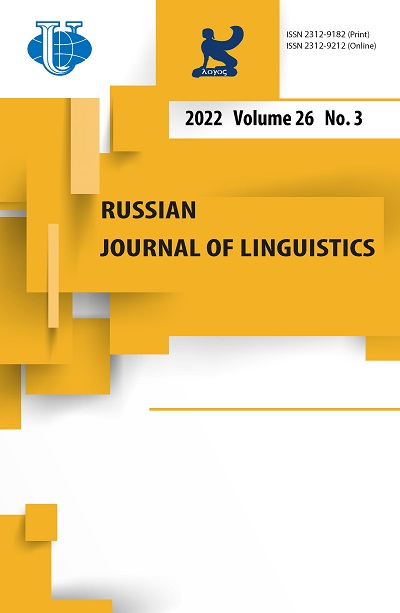Рецензия на книгу Seongha Rhee. 2021. Linguistic Forms at the Border of Lexis and Grammar: Grammaticalizaton of Adpositions across Languages. Seoul, Global Contents Publisher. ISBN 979-11-5852-358-9
- Авторы: Яэ С.1
-
Учреждения:
- Общеобразовательный колледж Да Винчи, Университет Чун-Анг
- Выпуск: Том 26, № 3 (2022)
- Страницы: 831-836
- Раздел: РЕЦЕНЗИИ
- URL: https://journals.rudn.ru/linguistics/article/view/32096
- DOI: https://doi.org/10.22363/2687-0088-31170
Цитировать
Полный текст
Аннотация
-
Об авторах
Сунхи Яэ
Общеобразовательный колледж Да Винчи, Университет Чун-Анг
Автор, ответственный за переписку.
Email: syae@cau.ac.kr
ORCID iD: 0000-0002-3313-9725
доцент
Сеул, Республика КореяСписок литературы
- Blake, Barry J. 2004[1994]. Case (2nd ed.). Cambridge: Cambridge University Press.
- Bybee, Joan L. 2011. Usage-based theory and grammaticalization. In Heiko Narrog and Bernd Heine (eds.), The Oxford Handbook of Grammaticalization, 69-78, Oxford: Oxford University Press.
- Correia Saavedra, David. 2021. Measurements of Grammaticalization: Developing a Quantitative Index for the Study of Grammatical Change. Berlin: Mouton de Gruyter.
- Diessel, Holger & Martin Hilpert. 2016. Frequency effects in grammar. In Mark Aronoff (ed.), Oxford Research Encyclopedia of Linguistics. New York: Oxford University Press.
- Fischer, Olga. 2011. Grammaticalization as analogically driven change? In Heiko Narrog and Bernd Heine (eds.), The Oxford Handbook of Grammaticalization, 31-42. Oxford: Oxford University Press.
- Heine, Bernd &Tania Kuteva 2005. Language Contact and Grammatical Change. Cambridge: Cambridge University Press.
- Hoffmann, Sebastian. 2005. Grammaticalization and English Complex Prepositions: A Corpus-Based Study. London: Routledge
- Hopper, Paul J. & Elizabeth C. Traugott 2003[1993]. Grammaticalization (2nd ed.). Cambridge: Cambridge University Press
- Hundt, Marianne. 2001. What corpora tell us about the grammaticization of voice in get-constructions. Studies in Language 25. 49-88
- Kopecka, Anetta & Marine Vuillermet (eds.) 2021. Source-Goal (a)symmetries across languages. Special issue of Studies in Language 45.1.
- Kuteva, Tania, Bernd Heine, Bo Hong, Haiping Long, Heiko Narrog & Seongha Rhee. 2019. World Lexicon of Grammaticalization (2nd ed.) Cambridge: Cambridge University Press.
- Lehmann, Christian. 2004. Interlinear morphemic glossing. In Herbert Ernst Wiegand (ed.), Morphologie: Handbucher zur Sprach- und Kommunikations-wissenschaft, Band 172. 1834-1857. Berlin: Walter de Gruyter
- Narrog, Heiko & Seongha Rhee. 2013. Grammaticalization of space in Korean and Japanese. In Martine Robbeets and Hubert Cuyckens (eds.), Shared Grammaticalization. With Special Focus on the Transeurasian Languages, 287-315. Amsterdam: John Benjamins
- Narrog, Heiko, Seongha Rhee & John Whitman. 2018. Grammaticalization in Japanese and Korean. In Heiko Narrog and Bernd Heine (eds.), Grammaticalization from a Typological Perspective, 166-188. Oxford: Oxford University Press
- Rhee, Seongha. 2014. Analogy-driven grammaticalization: A case of grammaticalization of sentence-final markers from concomitance-connectives. Linguistic Research 31 (3). 591-614
- Yae, Sunhee. 2018. Grammaticalization of ‘Case particle + -taka’ in Korean. Studies in Modern Grammar 86. 31-46.
- Ungerer, Friedrich & Hans-Jörg Schmid. 1996. An Introduction to Cognitive Linguistics. London: Longman.

















